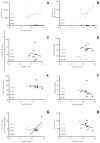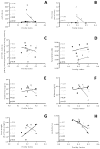Acetaminophen hepatotoxicity in mice: Effect of age, frailty and exposure type
- PMID: 26615879
- PMCID: PMC5976491
- DOI: 10.1016/j.exger.2015.11.013
Acetaminophen hepatotoxicity in mice: Effect of age, frailty and exposure type
Abstract
Acetaminophen is a commonly used analgesic that can cause severe hepatotoxicity in overdose. Despite old age and frailty being associated with extensive and long-term utilization of acetaminophen and a high prevalence of adverse drug reactions, there is limited information on the risks of toxicity from acetaminophen in old age and frailty. This study aimed to assess changes in the risk and mechanisms of hepatotoxicity from acute, chronic and sub-acute acetaminophen exposure with old age and frailty in mice. Young and old male C57BL/6 mice were exposed to either acute (300 mg/kg via oral gavage), chronic (100 mg/kg/day in diet for six weeks) or sub-acute (250 mg/kg, t.i.d., for three days) acetaminophen, or saline control. Pre-dosing mice were scored for the mouse clinical frailty index, and after dosing serum and liver tissue were collected for assessment of toxicity and mechanisms. There were no differences with old age or frailty in the degree of hepatotoxicity induced by acute, chronic or subacute acetaminophen exposure as assessed by serum liver enzymes and histology. Age-related changes in the acetaminophen toxicity pathways included increased liver GSH concentrations, increased NQO1 activity and an increased pro- and anti-inflammatory response to acetaminophen in old age. Frailty-related changes included a negative correlation between frailty index and serum protein, albumin and ALP concentrations for some mouse groups. In conclusion, although there were changes in some pathways that would be expected to influence susceptibility to acetaminophen toxicity, there was no overall increase in acetaminophen hepatotoxicity with old age or frailty in mice.
Keywords: Acetaminophen; Ageing; Frailty; Hepatotoxicity; Liver; Mice; Paracetamol.
Copyright © 2015 Elsevier Inc. All rights reserved.
Figures








References
-
- Al-Turk WA, Stohs SJ. Hepatic glutathione content and aryl hydrocarbon hydroxylase activity of acetaminophen-treated mice as a function of age. Drug Chem Toxicol. 1981;4:37–48. - PubMed
-
- Antoine DJ, Williams DP, Park BK. Understanding the role of reactive metabolites in drug-induced hepatotoxicity: state of the science. Expert Opin Drug Metab Toxicol. 2008;4:1415–1427. http://dx.doi.org/10.1517/17425255.4.11.1415. - DOI - PubMed
-
- Burgess CL, Holman CDJ, Satti AG. Adverse drug reactions in older Australians, 1981–2002. Med J Aust. 2005;182:267–270. - PubMed
-
- Chen TS, Richie JP, Lang CA. Life span profiles of glutathione and acetaminophen detoxification. Drug Metab Dispos. 1990;18:882–887. - PubMed
-
- Chen LH, Hu N, Snyder DL. Liver DT-diaphorase activity increases with age and dietary restriction in Lobund–Wistar rats. Age. 1994;17:65–70. http://dx.doi.org/10.1007/BF02434896. - DOI
Publication types
MeSH terms
Substances
Grants and funding
LinkOut - more resources
Full Text Sources
Other Literature Sources
Medical
Miscellaneous

